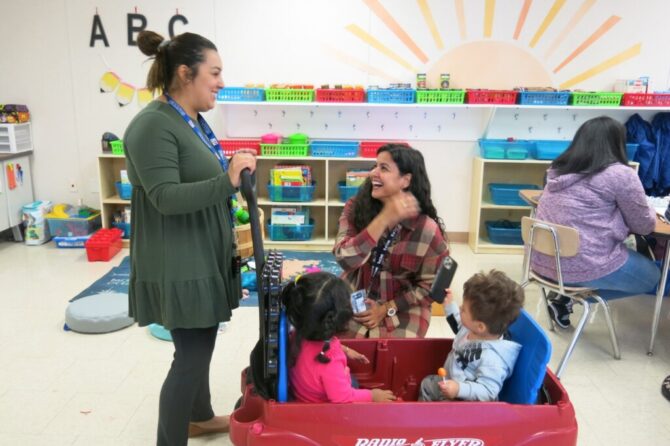WTOP: Last spring, after Frances Whalen had received notes about how well her daughter, Jordan Tucker, was doing in math, the eighth grader was invited to an accelerated math tutoring program.
The program was aimed at giving D.C. students a head start before the next school year began — and Whalen, a parent representative on the school’s board, said it seems to have worked.
It lasted about a month, for two-and-a-half hours a day, and the groups were usually no more than five students, reviewing old material and learning new concepts. Jordan was initially reluctant to spend her summer days learning math, but she knew it would be advantageous, Whalen said. Besides, she added, Jordan may sometimes act like she doesn’t enjoy math, but she does.
Jordan entered this school year ahead, Whalen said — with some of her assignments, “She was like ‘Oh yeah, that one was easy,’ because it was something from what she learned over the summer.”
Now, she’s even able to assist some of her classmates.
The Cesar Chavez Public Charter School for Public Policy has been running similar tutoring initiatives for months — some for students who need extra help, others for students who can get ahead and can even get high school credit while they’re still in middle school.
It’s called high-impact tutoring — at least 90 minutes of tutoring per week, divided across a few sessions before, during or after the school day, including immediate tutor feedback. Many sessions include three or fewer students, according to a D.C. Policy Center report.
It’s one of the city’s priorities in helping students catch up after the pandemic, during which D.C. students particularly suffered.
“Whatever we can do to give them a leg up,” Whalen said, “whatever we can do to help them refresh their skills, keep those skills retained — if there’s some type of program to help them, by all means we should be behind it, advocating for it, and also seeing what we can do to continue to keep it going, not just for one summer, but for a continuous thing. Because these students are going to consistently need help.”
Proponents praise high-impact tutoring, because immediate feedback is hard for teachers to provide in a larger classroom setting. Schools often select or recommend students for extra help, rather than putting parents in a position to have to pursue it.
But because the sessions involve small groups, the tutoring is expensive, and the future of the programs after federal stimulus money is exhausted is unclear.
Still, D.C.’s Office of the State Superintendent of Education has made a three-year, $40 million investment in the tutoring campaign. More than 2,200 students have received the small group tutoring to date, with the city on track to reach 4,000 students this year, Superintendent Christina Grant said. By the end of the initiative, Grant said, the city hopes to reach 10,000 of its 96,000 students.
“This is the wave of the future,” Cesar Chavez Middle School Principal Tre Christopher said. “This is the way we need to go in order to ensure that our scholars are really receiving what they need.”
‘Matter of equity’
When Grant joined the city as superintendent in the middle of the pandemic, Mayor Muriel Bowser had already announced the investment in high-impact tutoring — based, Grant said, on “a strong body of research that demonstrates that high-impact tutoring can produce dramatic gains in student learning.”
But Grant had had first-hand experience with high-impact tutoring. She worked as the founding superintendent of the Great Oaks Education Foundation, where students receive tutoring every day.
Across D.C., the small group tutoring sessions vary in how they look. At Cesar Chavez, Christopher said, meetings occur during the school day.
The school worked with CityTutor DC and Maryland Teacher Tutors, two groups that got grants as part of the city’s investment. Christopher said the school’s tutoring efforts began last school year, with a focus on improving math skills.
Sessions were held on Mondays, Tuesdays, Thursdays and Fridays. Twenty-three students met with tutors during the school day for 50-minute blocks. Usually, there were no more than three or four kids in a group. This fall, Christopher said, Cesar Chavez made tutoring more widespread.
“It truly is a matter of equity,” Christopher said. “If we’re saying that we are adamant about the progress and the success of our kids, it’s time for us to begin starting to put our money where our mouth is. The money is there; the programming is there; the partners are out there.”
Christopher said improvement in Math and English Language Arts is already evident. “It’s a costly investment,” Christopher said. “But we also know that it works for our scholars.”
At Eliot-Hine Middle School, in Ward 6, all students receive tutoring at least two days, and sometimes three, each week. Math tutoring occurs after school either Mondays and Wednesdays or Tuesdays and Thursdays, and each session is 45 minutes. Crystal Martin, the school’s intervention manager, said English Language Arts tutoring sessions are each 80 minutes, enabling kids to get 160 minutes of help each week.
Martin’s role at the school is new — she reviews data to determine how to best use the school’s resources to help kids. Eliot-Hine uses assessments to monitor each student’s progress. The school has a partnership with George Washington University for math tutoring, which is helpful, because Principal Marlene Magrino said it had been difficult to recruit staff to take on additional tutoring responsibilities.
“There were just so many additional factors that were happening for people in the school building and also in their personal lives,” Magrino said. “People were tired and didn’t want to do it, or just didn’t have the capacity to do additional time after work.”
At Eliot-Hine, some students have always been two or three grade levels behind in reading and math, Magrino said. Teachers didn’t need to explain that students were behind: “The students were telling us that, that they had missed a lot.”
The small group settings are helpful in reading, “because so much of learning to read is the immediate feedback you’re getting in the corrections from the teacher,” Martin said. “What we’re noticing from the pandemic is that the virtual learning and online learning impacted each student differently.”
Students are often excited at the prospect of improving, Martin said. A sixth-grade student who has faced several obstacles, Magrino said, recently said the sessions will help this school year be the one during which he learns to read.
‘Love tutoring’
As part of the city’s investment in the tutoring campaign, a handful of organizations received grants to partner with D.C. schools. Math Matters, a program at George Washington University, is among them.
Alicia Cagle, the program manager, said she built the model for high-impact math tutoring from scratch. Tutors, who are college students of various majors and backgrounds, meet with D.C. student groups they’re assigned to twice each week.
Math Matters partners with a handful of D.C. middle schools, with the tutoring scheduled either during the school day, during an intervention period or after school. Students are selected based on beginning-of-year test data, Cagle said. Demand is so high at some schools that they have to make a waiting list.
Last semester, the program worked with 93 middle school students across three D.C. middle schools. This year, they’re working with more than 160, and that number is rising. Tutors log session information so individual and overall progress can be monitored.
“That relationship that they built with the tutor really, really changed their mindset,” Cagle said. “I have actually had school staff, administrators, teachers telling us that their students have never worked so hard in math than they have in this program.”
Every GW student interested in joining the program has to be interviewed, and before working in schools, they’re trained in math concepts and relationship building.
Kerrin Li, a lead tutor at Eliot-Hine, is an economics major and was intrigued after getting an email about the program. She started last spring and is one of eight or nine GW students who tutor on Mondays and Wednesdays. To prepare for each session, the college students talk about curriculum concepts, how to handle difficult situations, building relationships and entering communities respectfully, Li said.
Before diving into math concepts, Li and her peers ask the middle schoolers about their days or weekends, “because I understand that doing more work after a long school day can be really tedious.”
Students who said their parents made them attend the sessions often admit to enjoying it after a few meetings, Li said.
“I don’t necessarily want to be a teacher in the future,” Li said. “But I do very much love tutoring.”










